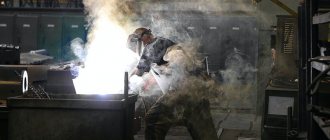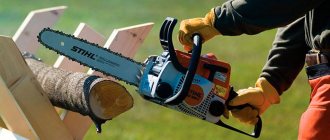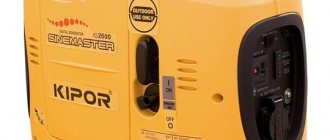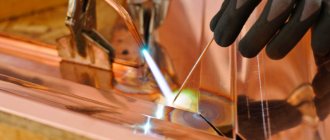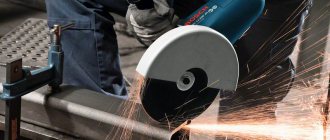Home / Devices
Back
Reading time: 2 min
0
739
The welding inverter has long proven itself to be an affordable and convenient option for various purposes, including household ones. It will be convenient for simple repairs or welding of small parts.
It will be especially appreciated by summer residents or car owners, since it works well with unstable electrical voltages below 220V.
And if there is no electricity at the site at all, a welding generator will come to the rescue.
- Features and types
- Which option is better
- Device classification
- Conclusion and conclusions
Types and features of devices
Depending on the tasks to be solved, as well as the power allocated, generators are classified into several categories.
Gasoline devices for summer cottages are among the most common types of devices. They are mini power plants capable of providing power up to five kilowatts.
Their distinctive feature is their low weight and small dimensions. In this regard, they are convenient to transport.
Such devices do an excellent job of providing a cottage, private home or small workshop with electricity during power outages and failures. Thus, this type of equipment will be the best household option.
Generator for welding work.
A gasoline welding generator is a type of unit designed to produce electricity with a power of up to ten kilowatts. This equipment can easily cope with long-term loads and can provide uninterrupted operation for eight hours.
When choosing such a device, you should pay special attention to the motor manufacturer. There are often cases of rapid failure of this unit due to poor build quality.
Considering the battery life, an important criterion is such a parameter as the volume of the fuel tank. If its capacity is insignificant, then the duration of uninterrupted electricity production will be automatically limited by the amount of fuel.
The presence of high-quality noise insulation and an electric starter are also important characteristics that make work more comfortable and enjoyable. Of course, if finances allow, it is better to give preference to units with the specified elements.
The most modern overhead valve devices are even compared to a diesel welding generator in terms of power produced. Such installations are characterized by low noise levels, high performance and durability.
It makes sense to purchase a gasoline unit only in cases where you plan to use inverter welding and other devices for a long time without access to the network. The most common case is construction work. In this case, it is simply impossible to do without mini power plants.
There are also more powerful devices that can provide power of about twenty kilowatts or more. They are equipped with automatic start and are massive, large-sized stationary units.
Device
Choosing the right generator for an inverter welding machine or other type of welding is only possible if the operating principle of the device and its design are fully understood.
The welding generator device is a frame structure with an engine and an alternator mounted on it through shock absorbers. Torque is transmitted to the unit’s engine through a special coupling from the alternator rotor.
The result is a three-bearing arrangement based on bearings on the rotor and the end of the crankshaft. The third bearing is located at the output of the engine power take-off shaft.
The following elements are also placed on the device body:
- current indicator;
- sockets;
- buttons or toggle switches that allow you to change modes;
- circuit breaker;
- connectors for welding cables;
- regulators.
When purchasing such devices, you should understand that they are capable of producing a certain amount of electricity. In this regard, it is important to pay attention to the power of the generator so that its operational capabilities coincide with the requirements of the user.
Based on functional parameters, the following types of devices are distinguished:
| Device type | Characteristic |
| Transformers | Characterized by relatively low cost. Convenient and small-sized devices that provide alternating current. |
| Rectifiers | Units producing direct current. Used for processing stainless steel parts. |
| Inverter type | Devices with high-precision mode settings. Used for operation in automatic and argon-arc modes. |
Depending on the type of fuel used, gasoline and diesel welding transformers are distinguished. The first ones are characterized by low power, but their price is also affordable. It is impossible to use such devices for long-term operation in difficult conditions. The best area of application for such generators is various small household jobs.
Electrical circuit of a commutator welding generator.
Diesel options are reliable and have a wide range of power options. In addition to a long working life, these units boast the ability to operate under the influence of low temperatures.
Of course, the price of these devices is significantly higher. However, if the generator is used frequently, the cost pays off fairly quickly. Which device option to choose is up to the user to decide. Here you need to start only from the assigned tasks and financial capabilities.
Operating principle of a generator with independent excitation.
The design of generators of this type is equipped with an independently excited winding, which is powered by some external direct current source. In addition, the circuit also has a demagnetizing winding connected in series. The current in the circuit is regulated using a rheostat. If the current in the welding circuit increases, the magnetic flux created by the demagnetizing winding will also increase. At the same time, the magnetic flux created by the independent excitation winding will remain the same. This leads to the fact that the voltage at the generator terminals drops, which creates a falling external characteristic.
Principle of operation
The inverter needs a welding gas generator as a source of voltage necessary for its operation.
The operating principle of a conventional generator is based on the conversion of mechanical energy into electrical energy. The output in such devices is an alternating voltage, characteristic of power surges and fluctuations.
Thus, the productivity and efficiency of the device decreases significantly, and the service life of the device is also reduced.
What kind of generator is needed for a welding machine?
There are two main ways out of the situation:
- use power plants with a significant power reserve;
- use a station that produces a stable voltage.
Both options have their advantages and disadvantages. Thus, the choice must be made based on the characteristics of the work being performed.
How to do it yourself?
You can make a generator for welding yourself. For these purposes, it is better to use a separate room, for example, a workshop or garage.
The first element with which to begin production is the frame. A corner measuring forty by forty millimeters is perfect for it. After the required length is cut using a grinder, holes are drilled in it for the motor and generator. These elements are secured to the frame with bolts.
It is worth noting that in this situation you can assemble a welding machine from a car generator.
Next comes the installation of wheels to the base of the frame to ensure easy movement. The wheels can be secured by welding or bolts.
Features of welding generators.
The principle of operation of the device is based on the transmission of torque from the motor to the generator, as a result of which a current is generated.
This circuit underlies the operation of each device.
The unit can operate without a gas generator. The generator can also be supplied with mains voltage, which is subsequently converted into the required current for welding.
As you can see, making a welding generator yourself is not difficult. It is also possible to make a welding machine from a laboratory autotransformer.
What to look for when choosing?
When choosing a generator for a welding machine, it is important to consider some device parameters. For example, it was previously mentioned that a gas generator is incompatible with high-power inverters. This point is due to the inability of such units to compensate for voltage surges.
So how to choose a generator for a welding inverter? This issue has its own nuances that require a competent calculation of the power of the device. In the inverter type, it is equal to the maximum consumption. However, it is worth taking it with a small margin of twenty or thirty percent of the total productivity of the station.
Thus, to find out which generator will power this or that equipment, you should multiply the arc voltage by the maximum current consumed. The marked values are usually given in the operating instructions.
The value obtained as a result of the calculation should be divided by the efficiency factor. This value is the maximum voltage that allows you to select a gasoline generator.
Even taking into account the large power reserve, it is better to choose an inverter-type device. The energy produced by such a device is of higher quality and has less power fluctuations, which is an important criterion in welding.
Wheeled welding machine (WAM)
When choosing a welding machine, we think about its power, dimensions, technical characteristics and additional functions. But we rarely think about the conditions in which our future welding machine should operate. But the choice of equipment largely depends on this.
If you expect that you will often work without an electrical outlet nearby, then you will need a mobile welding unit, also known as SAC (wheeled welding machine). The SAK welding machine is not just a welding machine. This is a full-fledged generator that can work even in an open field. In this article we will explain in detail what SAC is.
Popular brands
There is a wide range of different gasoline and diesel welding generators on the market. This review presents for consideration the most interesting, in our opinion, device models.
The generator for the welding inverter must fully satisfy the demands made by the equipment itself. Often the correct parameters need to be calculated in advance.
An excellent choice would be the Kraton GWG-5.0/180 petrol station, which combines an electric generator with a welding machine. Such a unit will be most useful to various emergency services and builders. It is worth noting that in a garage, as well as in a small workshop, such equipment will never become superfluous.
It already combines components such as an electric generator and the welding machine itself. The noted state of affairs relieves the consumer of thinking about the compatibility of these components.
Schematic diagram of a valve generator.
In addition, the unit is distinguished by the presence of wheels and folding handles, making it easy to transport. Available panels include a voltmeter, protection devices and an ignition switch.
Gesan GS 210 DCH is another excellent option that combines both a generator and a welding machine. Such a combination will become indispensable in carrying out various construction or repair work in the absence of electricity.
We should not forget that even the availability of an electrical network in the immediate vicinity cannot guarantee the availability of sufficient power. And the voltage quite often differs greatly from the declared 220 volts. Is it worth remembering the large losses that occur in long electrical cables stretched from the outlet to the device.
All of the above factors will negatively affect the quality of work. In this regard, the choice of the Gesan GS 210 DCH station will be very appropriate.
Gasoline stations with the ability to operate using MMA and TIG-DC methods are in demand among a small circle of people. These are mainly specialists who are professional welders. Similar installations include the Telwin Motoinverter 254 CE model.
The device is used in the same areas as other devices: in construction and repair. In other words, everyone who needs electricity without access to the network purchases such units.
A distinctive feature of the Telwin Motoinverter 254 CE, in addition to the ability to work with the TIG method on direct current, is the ability to work not only with thick material, but also with thin-sheet metal workpieces.
In addition, devices with a power consumption of up to three kilowatts can be connected to the device. To simplify the welding process, various additional functions are provided here: hot start, Anti-Stick, Arc Force.
https://youtu.be/MXDzKmpZEO4
What is SAC: general information + features
When a person chooses a laser machine, he first of all pays attention to the output power, dimensions and other technical characteristics. Very rarely does a buyer think about the conditions under which he will use the welding unit in the future.
I mean thinking ahead, and not a momentary impulse to acquire 1-2 things.
SAK (Wheel Welding Machine) is a hybrid design that combines welding and a mobile power station. In addition to the classic abbreviation, this equipment is often also called SAG or welding power station.
Please note: when building in hard-to-reach places or in new areas, the problem of connecting to a power source is extremely acute. Recharging without obtaining the appropriate permits will result in penalties.
The key design feature of welding wheel units is the presence of an internal combustion engine. It is according to this that equipment is classified within our state. I will describe the detailed distribution by motor type for power supplies below in the table.
| Type | Subspecies | Description | |
| Petrol | Inverter portable | These are small generators with a power of up to 1 kW. Manufactured in a “suitcase” form factor. They are purchased for home use, because the intensity of the supplied electrical energy is not enough for industrial purposes. | |
| Inverter up to 6 kW. | Increased power also entails increased weight of the unit. Such models are supplied in the form factor of a chest on wheels. To prevent equipment parts from suffering mechanical damage, a frame of pipes is usually made around the engine. | ||
| Gasoline up to 10 kW | Designed for use at high intensity over long periods of time. Form factor like a barrel on wheels. | ||
| Diesel (DGS) | Design execution | Classical | Linear type rotation generator |
| Open | Used in buildings. | ||
| Soundproof | If a “quiet” operating mode is required. | ||
| Van | For difficult climates. | ||
| Mobile | In mobile structures. | ||
| Type of current | Low voltage | up to 1 kW. | |
| High voltage | from 1 kW to 10 kW. | ||
| Generator type | Parallel | Generation of current at standard frequency. | |
| Asynchronous | Generation of current of non-standard frequencies. | ||
| Welder | Constant | DC generation. | |
| Removable | AC current generation. | ||
Among gasoline power plants, container-type power plants can also be distinguished. For constant outdoor use, modification of the external casing is required (noise-absorbing casings are used) + fine adjustment to the form factor. Typically, such equipment is made to order. Peak power can be up to 200,000 watts.
Among diesel equipment, three concepts should not be confused - “power plant”, “unit” and “generator”. Each of the objects has its own design + differs in the scale of assembly.
Design features of SACs:
- Built-in cooling system that protects sensitive parts from overheating. With high-quality cooling, the operation of the welding unit will not be suspended at the most inopportune moment;
- the part of the equipment that is responsible for the welding operation itself is manufactured as an induction generator;
- The engine is usually covered with a special fireproof casing to prevent external negative influences of weather. The second function is to protect the welder from potential injury;
- the lower part of the frame is equipped with a chassis. The wheel size may vary and depends on the operating conditions of the equipment. For indoor use, these are small ones, but if we are talking about transporting the SAC over long distances (like a trailer), the diameter of the wheels increases significantly. All these points are discussed individually with the supplier of the units.
When referring to the technical characteristics of SACs, it is important to pay attention to the type of welding current and its peak power. Usually this is up to 120 A. The second, no less important selection rule is the ability to connect other electrical equipment to the unit. It is irrational to drag such a colossus behind you just for the sake of welding. It is necessary to select units that are capable of producing an output voltage suitable for most classic power tools. Such SACs can be useful during construction or installation work, and even in everyday life as a temporary power source for housing.
Exploitation
Achieving the highest possible performance of devices and extending their service life depend on proper operation, be it a do-it-yourself welding generator or an industrial gas generator and welding inverter.
Features of using welding stations primarily depend on their format. These can be industrial, household or professional devices.
The use of equipment of the first type in large or industrial production presupposes that the device has a wide range of capabilities, allowing for manual, semi-automatic, and other types of welding.
An industrial type generator requires proper maintenance to operate. Adjusters and process engineers are responsible for this. The latter, among other things, are developing unique connection methods.
The format for using household units differs significantly from industrial ones. The usual place for work using such generators is a cottage, garage, workshop.
The most common welding method is manual. Of course, in an ideal case, the owner of this device is an experienced welder. Nevertheless, quite often a person becomes a professional after purchasing the unit.
Connecting a diesel generator.
When using a generator, you must follow a few simple rules:
- the device should be used on a horizontal plane;
- It is better to use workpieces with a thickness of three millimeters or more as the first parts to be welded;
- learn to hold the arc correctly and not burn through products;
- do not rely on luck when working with the device, but carefully read the instructions, which contain all the necessary information;
- special attention must be paid to safety precautions;
- It is better not to operate the unit in dusty rooms, since generators “do not like” dirt.
When working with an inverter welding machine, it is important to take into account the specifics of its connection to the generator. If the station is incorrectly selected, the inverter may fail. In this case, even taking into account only power, as noted earlier, does not solve the issue of compatibility.
Selecting a welding generator
When choosing a generator for a welding inverter, you need to understand all its varieties. We will briefly talk about all the features that need to be taken into account.
Gasoline or diesel
The question “Which generator is better: gasoline or diesel?” can often be found on welding forums. And everyone who chose to buy this or that generator is ready to prove that their choice is the most optimal. But this approach is fundamentally wrong. When choosing the type of welding generator, you need to understand for what purposes you will use it and only then draw conclusions.
At the moment, gasoline generators are the most common. They are inexpensive, easy to maintain and use, weigh less than diesel engines, and can operate stably at low temperatures. Disadvantages include high fuel consumption and lower durability (on average up to 3000 hours of operation).
As for diesel generators, they are more productive, reliable and can withstand significant loads. A diesel generator always ensures stable operation in any welding mode. Also, diesel models are very economical and consume little fuel.
It would seem that the advantages are obvious. But the problem is that most diesel generators are too powerful for home use. Stores offer generators from 5 kW and above, so they are not suitable for domestic purposes. In addition, diesel models are significantly more expensive and heavier than gasoline models, and have difficulty operating at low temperatures.
Which to choose?
You decide for yourself which generator you need to complete your tasks. Both gasoline and diesel generators are capable of providing autonomous power supply even in field conditions. But the scope of application of these devices is radically different.
Welding from a generator with a gasoline engine should not exceed 6 hours, since the generator simply cannot withstand heavy loads. For more complex tasks, there are diesel generators that can operate almost around the clock (if the outside temperature is not sub-zero).
But admit it, do you really cook in your dacha for 6 hours without a break? Hardly. If you need a generator for home use, then a gasoline model will be the most optimal. It weighs significantly less than a diesel generator, but is more stable in operation and costs less. Leave diesel models to the professionals who know what they're for.
DC or AC
The welding generator can generate both direct and alternating current. Most budget household models generate only one type of current, while more expensive models can be universal.
If you are choosing an inexpensive generator for your home, but quality of work is important to you, then we recommend a DC welding generator. It provides better quality seams and allows you to work in small volumes. Any type of electrode can be used for welding. The seams are not only of high quality, but also smooth and aesthetic. But to use such a generator you need to purchase a rectifier.
As for alternating current generators, they are somewhat cheaper than direct current generators, but the seams are of lower quality and durable. This is due to the fact that the design of an alternating current generator itself is much simpler than that of a direct current generator. Opt for an alternator if you have a small budget and do not need to weld high-quality seams.
Generator class
Welding generators are conventionally divided into 3 classes: household, semi-professional and professional.
Household ones can generate up to 200 Amps, which is enough for most inexpensive inverters. If you use a more or less powerful semi-automatic machine for welding, then it is better to purchase a semi-professional welding generator capable of generating up to 300 Amperes. Professional models that produce more than 300 Amps are usually not used at home, since their power is excessive for most household tasks.
Number of welding stations
A welding generator can power more than just one machine if it is equipped with several connectors at once. Such models are called multi-station and are designed to connect several welding machines at once. When using such a generator, several welders have the opportunity to work simultaneously from one generator, which is extremely convenient.
However, most inexpensive models are still single-station, since in everyday life it will be used by one person, and there is no need for collective work.
Dimensions and weight
If you are going to purchase a generator for home use, then make sure that it is portable. That is, have acceptable weight and dimensions. Gasoline generators often weigh less than diesel generators and are generally compact. But keep in mind that in most cases, the larger the generator, the more powerful it is.
